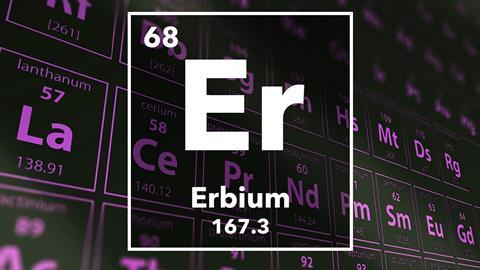Chris Smith
This week we meet the man and one of the chemicals that led to the birth of the science of spectroscopy, but is pink your colour?
Andrea Sella
A couple of years ago a colleague popped his head round my door and said, as chemists do, "I'm on the scrounge". It's quite common in chemistry departments – you want to do a quick experiment and just want a smidge of something without having to order a whole bottle. So you ask a friend whether they have a bit of whatever. "Have you got some erbium oxide?" "Sure I said. I've got some up in the lab". A few minutes later my friend went off with a small bottle containing a delicate pink coloured powder.
A few weeks later I saw him in the stairwell and asked him how he'd got on with the erbium. "It's amazing stuff. You HAVE to see this." He replied. He pulled out of his pocket a sample vial containing some stunning pink crystals that glinted alluringly. "Wow!" I said – chemists are always impressed by nice crystalline products. "It gets better." he said mysteriously. He beckoned me into a hallway that had recently been refurbished. "Look" he said.
As the crystals caught the light from the new fluorescent lights hanging from the ceiling, the pink colour seemed to deepen and brighten up. "Wow!" I said again. We moved the crystals back into the sunlight and the colour faded again. Moving the crystals back and forth they glowed and dimmed in magical fashion.

It was a stunning example of the luminescence of the group of elements, the rare earths, of which erbium is a member. The red phosphor in the fluorescent lights must have contained erbium ions and because the emission wavelength of the phosphor exactly matched the absorption in my friend's crystals, resonant absorption occurs causing the magical glow.
The rare earths were revealed to the world quite by accident by a Swedish lieutenant and rock-hound Carl Axel Arrhenius in 1787 in a quarry on the island of Vaxholm in Sweden, where the small town of Ytterby is located. The mineral that Arrhenius had discovered would lead to the discovery of 16 elements, all of them with remarkably similar properties. And the small village of Ytterby would provide the inspiration for the names of several of them: ytterbium, yttrium, terbium, and the element of this podcast, erbium. Others got names like scandium, holmium, thulium in recognition of the region whence they first appeared.

For over a century, controversy raged amongst chemists about these elements. And one of the key players in this chemical row was Robert Bunsen, the co-inventor with Gustav Kirchoff, of spectroscopy. Together they had had the idea of putting chemical compounds into a flame and analyzing the resulting light with a prism. The spectra they observed proved to be amazing analytical tools - Kirchoff would use the method to identify elements on the sun. The method rapidly became one of the central pillars of chemistry.
But like many others working in the area, Bunsen was intrigued by the faint colours of the lanthanides, and their remarkable invariance. Erbium compounds, regardless of the partner – the oxide, the chloride, fluoride, amide, hydrocarbyls - are almost invariably faint pink. Over a period of three long years Bunsen methodically carried out the hundreds of crystallizations need to purify the elements, and then meticulously measured and sketched the spark spectra which contained many sharp bands of varying intensities. It was a spectroscopic tour de force for its time. At last, in May 1874, Bunsen finished writing his monumental manuscript. With a feeling of relief, he finally headed off to the local pub for lunch.
Imagine the poor man's horror when he got back to the lab and the manuscript was gone. A round bottom flask of water on the desk had focussed the spring sunshine from the window and set fire to the entire pile. Years of work reduced to ashes. After venting his despair in a couple of letters to friends, Bunsen painstakingly redid the work from scratch, laying the foundation of our understanding of the electronic structures of elements such as erbium.
We now realize that the valence electrons of erbium – of which there are 11 in its compounds, are buried deep within the core of the atom. Their location makes them remarkably insensitive to the world outside – which is why the colours are so consistent from compound to compound.

But what Bunsen could not know, was that there were spectroscopic bands in the infrared part of the spectrum and it is these that are what makes erbium so valuable to us today. As you are probably aware, most of our telephone calls and internet data transfers are carried by optical fibres. These gossamer thin threads of glass are of a rare optical perfection. But much like light passing through the atmosphere, scattering occurs – photons of light collide occasionally with the chains of glass in the fibre and the light is attenuated, limiting the length of fibre one can use. This phenomenon, called Rayleigh scattering, is the same that causes the daytime sky to be blue and sunsets to be red. The shorter the wavelength, the greater the scattering. Erbium light – at 1.55 microns, in the near infrared region of the spectrum – falls right where Rayleigh scattering is at a minimum but away from where bond vibrations of the glass absorb infrared light. Erbium lasers and amplifiers are therefore the hub around which all of our modern telecommunications revolve. So the next time you phone a friend and say to them "It's a lovely day. Let's go to the park", think erbium. It may only be the 44th most abundant element on our planet. But it punches far above its weight.
Chris Smith
How ironic that the man who invented the Bunsen burner ended up with his work going up in smoke thanks to the sun. That was UCL chemist, Andrea Sella telling the story of Robert Bunsen and the element erbium. Next time to the philosopher's stone and the man who boiled up urine expecting to get gold, and found this element instead.
Nina Notman
phosphorus was first made by Hennig Brandt in Hamburg in Germany in 1669 when he evaporated urine and heated the residue until it was red hot. Glowing phosphorus vapour came off and he condensed it under water. And for more than 100 years most phosphorus was made this way. This was until people realised that bone was a great source of phosphorus. Bone can be dissolved in sulfuric acid to form phosphoric acid, which is then heated with charcoal to form white phosphorus.
Chris Smith
But what can we do with it? You can find out next time when Nina Notman tells the tale of Phosphorous on next week's Chemistry in its Element, I hope you can join us. I'm Chris Smith, thank you for listening and goodbye.













No comments yet